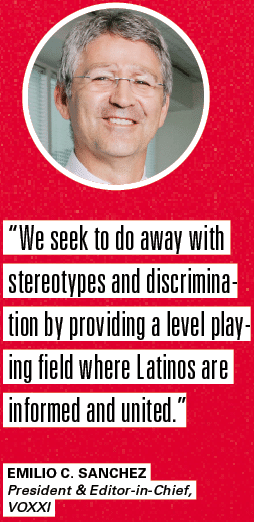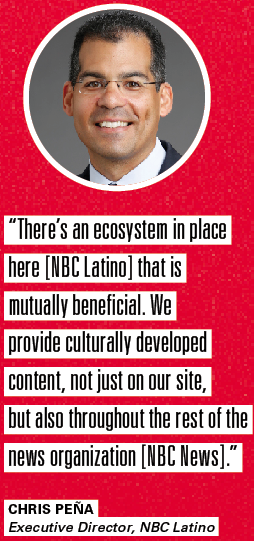From media corporations to start-up news websites, the push to deliver culturally relevant news to 52 million people—17 percent of the nation’s population—has become more than just a trend; it’s become the norm.
Hispanic media long had been told by the voice of Spanish television, newspapers, radio, and Internet outlets. Recently, big names such as NBC, Univision, Fox News, ABC, and CNN have launched Hispanic-focused news in English relevant to the Hispanic community.
Leading networks, traditionally English speaking, are not only delivering their news outfitted to the Latino culture, but they are dedicating Hispanic-centric channels to the trend.
The move has hit every major news platform from mobile to the big screen, cable television, and social media—and the move makes sense with some 74 percent of third-generation Hispanics born in this country consuming their news in English, which according to a 2012 survey conducted by the Pew Research Center, is growing as the dominant language for a large percentage of Hispanics.
News outlets young and old have been scrambling to appropriate content in such a way that appeals the new audiences of our time—people want information, quick, readily available, accurate, and tailored to their interests.
The preeminent outlets carrying the new Hispanic voice are run and managed by Hispanic natives, first and second-generation immigrants.
Finding the right tone, a successful business model and the right outlet to distribute content, emerging media outlets like VOXXI, whose name is a mix of VOX meaning “voice” and XXI meaning “21st,” are setting the stage to deliver Hispanics 100 percent original content.
 “We seek to do away with stereotypes and discrimination by providing a level playing field where Latinos are informed and united,” says Emilio C. Sanchez, president and editor-in-chief of VOXXI.
“We seek to do away with stereotypes and discrimination by providing a level playing field where Latinos are informed and united,” says Emilio C. Sanchez, president and editor-in-chief of VOXXI.
Sanchez has more than 20 years of experience working in the media industry spanning from reporting jobs in Spain to Belgium to Washington and Miami. The Spanish native knew immediately that he had to create something new—and soon, VOXXI was born. “VOXXI is digital, new and fresh, and reaches new audiences in way that other media outlets left out,” Sanchez says.
“We focus on areas where the mainstream media is lacking or where information tailored to Hispanics is missing,” says Sanchez, adding the outlet hones in on politics and immigration, an extremely important issue for VOXXI. “We are constantly striving to give immigrants a voice, to dispel any misconceptions about our population.”
Several newspapers, including The Tribune Co., and media bodies in New York and Arizona moved towards cross-cultural sharing among ethnic newspapers three years ago focusing on immigration. Many news companies followed suit with new brands popping up quickly with a their own strong voice, content, and audience base, including VOXXI, Hispanicize, Mex in the City, and Guanabee.
Looking at the statistics from the latest US Census, the nation’s Latino population grew to more than 50 million, which is up 46.3 percent from 10 years prior; more than double its size from 1990.
Many big names began to yield their news to these statistics. Tribune Co. for example, launched Hoy Chicago, a free newspaper that increased the company’s circulation by 40 percent in 2010, according to this year’s Annual State of the Media News Report. Based on Hoy’s success, Tribune Co. decided to publish several other Hispanic weeklies.
NBC News also looked at this gapping hole and jumped on the opportunity to figure out how they can fit in. In 2012, the news organization launched NBC Latino.com, “a new voice of American Hispanics” which touts itself on taking Hispanic news beyond the usual conversation.
 Chris Peña, executive director of NBC Latino describes the news outlet as a digital start-up within a legacy media company, the function of term he calls “interim entrepreneurship.” He adds, “There’s an ecosystem in place here that is mutually beneficial. We provide culturally developed content, not just on our site, but also throughout the rest of the news organization [NBC News].”
Chris Peña, executive director of NBC Latino describes the news outlet as a digital start-up within a legacy media company, the function of term he calls “interim entrepreneurship.” He adds, “There’s an ecosystem in place here that is mutually beneficial. We provide culturally developed content, not just on our site, but also throughout the rest of the news organization [NBC News].”
NBC Latino wants to be where the fish are—they want to be on tablets, mobile phones, laptops, and computers. “You have to be in all of those places,” Peña says.
“In almost two decades, I’ve gotten a wide-range of experience and immersion in the media,” Peña says. “I’ve seen it evolve.” Peña has been deeply engaged in television news since his senior year of college. He’s been a television photographer, editor, director, and executive producer working in Spanish language media and English language news and sports.
Peña careens his personal experience with his professional role in the news organization. He oversees the sites content, which is geared for the target demographic of 25- to 49-year-old Latinos.
A native of the Dominican Republic, Peña came west at the age of seven only speaking Spanish. “That type of aspiration component of the immigrant experience is what we try to convey at NBC Latino. Nobody chooses to leave their homeland because they believe it’s going to be worse on the other side where they’re going. It’s about wanting a better life.”
Embracing social media without question
Peña doesn’t let his team of nationwide reporters rely on users having a singular URL experience, he wants his reporters and writers to find content through the side door be it on a user’s Facebook or Twitter feed. “We need to make sure that our stories are easy to share, that we are engaging our users, we are having real conversations with users,” Peña says.
VOXXI has, too, found its way through the digital shift. The outlet has found its strongest voices through social media. “We embrace the changes and opportunities the digital sphere brings us,” he says. The independent media company aims to bridge the information gap, connect Hispanics to their culture and relate connections to South America, Central America, and the Caribbean, Sanchez says.
For more than 16 years, the Sofrito Media Group has managed and produced branded projects that appeal to the Latino culture in America, including, but not limited to: web properties, live events, social-media campaigns, Internet radio production, content development, and consulting services. The company’s flagship website, Sofrito For Your Soul, is considered one of first Pan-Latino blogs before blogs became a part of mainstream media.
“It’s been interesting as this company and the services we offer have been created in a very organic way,” says George Torres, founder and CEO of the Sofrito Media Group. “Everything we have done has been to fill a void that existed.”
As one of the first players in the Latino stage, Torres says just because you’re first, doesn’t mean you’re doing it right. You personally are your brand, the passion, and the vogue of the Latino culture—a common fashion throughout Hispanic media.
“Social media is important to us because traditional media does not get us,” Torres says. “It allows us to share stories that would normally not spread past our immediate circle of influencers offline. It allows us to build relationships that lead to collaborations that build real business opportunity.”
For many Hispanic outlets social media is the crux for balancing power of strong cultural influence online; creating a robust digital presence is important because it spreads like wildfire. Whether you’re on the corporate c-level or a small start-up, the budget allocated for social media is vast as it drives significant traffic, but you must know whom you are targeting. “It [the Hispanic/Latino audience] is not a monolith; there is homework to be done to successfully capture this audience,” Torres says.
Creating a vibrant meeting place
With the Hispanic population quickly embracing new media and utilizing the tools of digital journalism, the emerging market of Hispanic media needed a meeting point to collaborate and celebrate the growing population. Enter Hispanicize, an annual conference for the Latino marketing and blogging industry, which draws comparisons to SXSW, for its tech and media offerings.
Hispanicize was conceived four years ago to fill a void in the Hispanic community. “No event or conference had ever gathered the industries we chose to bring together like we did: social media, marketing, journalism, film, and music. We’ve given these industries a stronger, united voice,” says Manny Ruiz, founder and creative director of the event. Ruiz also is founder of sister companies Hispanicize Wire and Hispanicize digital.
“What unites everyone about the Hispanicize event are three things: everyone attending the event is in some way or another a content creator; a shared interest in the US-Hispanic experience; an intense interest in how digital and social media is impacting all industries. When you put these people together as we have—the energy level and the creativity of Hispanicize is off the charts,” Ruiz says.

Cultural parenting gets social
Latina Mom Bloggers brings together 400 Latina bloggers that write about a plethora of topics including parenting, crafting, cooking, cuisine, fashion, lifestyle, and health in both English and Spanish. “Latinas are taking the blogging world by storm,” says Cristy Clavijo-Kish, CEO, partner at Hispanicize digital and co-CEO, partner at Latina Mom Bloggers.
The blogging platform along with Hispanicize digital were developed to connect the growing number of bloggers with brands that want to work together under one all-encompassing umbrella platform. “They’re creating unique content that connects their cultural heritage to their daily lives and blogging about everything in between,” Calvijo-Kish says.
A fervent Hispanic brand builder, Clavijo-Kish was having trouble finding digital content that resonated with Latina mothers from a cultural perspective. There was little content out there to help mothers as their children age into the challenging tween and teenage years. “So much is at stake with the foundation that you lay for your children from school success to self-esteem, socialization, being proud of your cultural heritage, building empathy for others, and more,” she says.
The more she searched, the less she found. So she created Los Tweens & Teens, a growing blog resource platform that gives these issues and topics voice. In the fall, Clavijo-Kish is launching My.LosTweens.com, a site that will allow kids and teens together with their parents to create their own content to share with the Hispanic and multicultural community.
Building a new business platform
“To grow quickly, we established a strategy to partner with different companies to give us a strong base and the capability to expand our business,” Sanchez says. “We don’t use our access to the US-Latino market as the way to improve the relationship with the Hispanic community. We are the community.”
“We filter our content at NBC Latino through our mission statement and in the mission statement the very last sentence says take Hispanic views beyond the usual conversation, to something more empowering, more inspiring and more energizing. Our content has to fit within that rubric. I make sure the site stays on track, that we are interfacing well with the larger organization,” Peña says.
Covering topics from people and food to education and politics, NBC Latino continues its impassioned search for relevant content. The outlet produces some 4,000 stories per year of original content and reporting. “For me it’s all about looking at the landscape for opportunities in which to better our audience with relevant content—grow audiences, grow revenue,” Peña says.
VOXXI measures success through awareness, says Sanchez. “We have metrics that we keep, of course, but our most valuable indicator is engagement with our readers and knowing that we are covering information that’s important and culturally relevant.”
The Future Looks Bright
Looking ahead, there’s only exponential growth for Hispanic media outlets. The 2011 US population map shows steady growth in traditionally Hispanic areas. New growth is emerging in areas where Hispanics were recently unknown, according the Nielson Company. Outlets have poured the concrete in which the Hispanic community with continue to mold and remodel to fit their ever-changing needs.
The Latino population will continue to swell albeit any immigration impediment. language, culture, and who owns what greatly influence technology and media in the Hispanic market, according to a 2012 Nielson study, which affirms what the market has known for more than a decade: this is a bolstering, rich segment of our society that media outlets nationwide should continue to evolve and embrace. It’s no longer a sign of things to come—it is the face of today.

